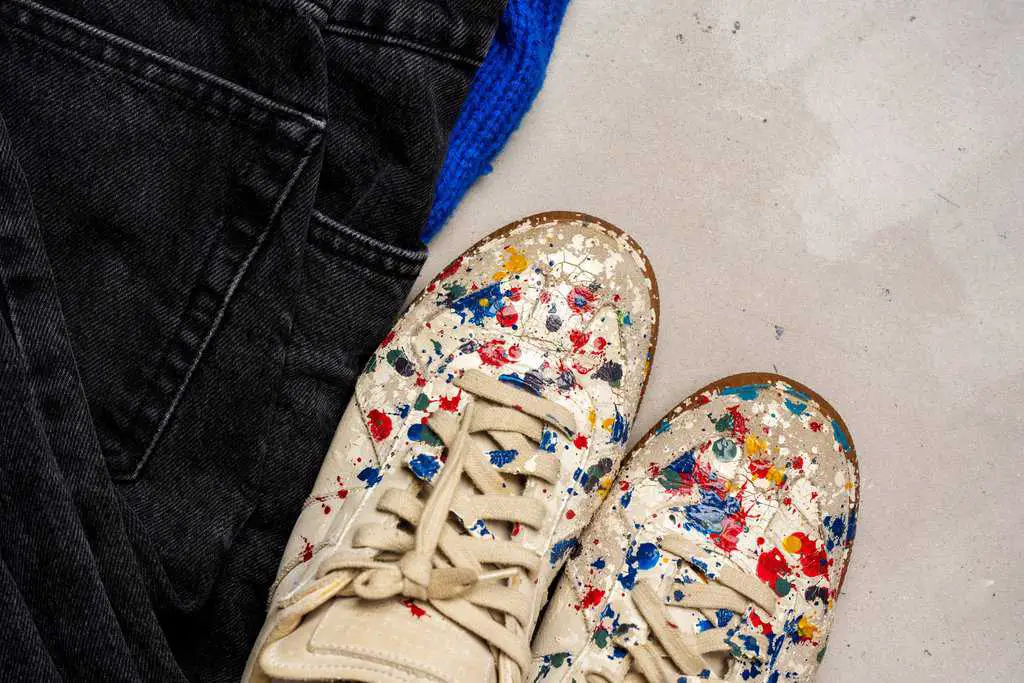Acrylic is a great painting medium, it’s a relatively safe medium to work with, and it works on various types of materials and surfaces. Unfortunately, it also works on leather. Whether you or your child has accidentally spilled some on your couch or you changed your mind about your artwork, removing the paint is probably the next thing on your mind. Thankfully, as easy as acrylic is to use, it is also relatively easy to remove.
What does acrylic paint do to leather?
Fortunately, acrylic paint is not very harsh and has no immediate risk of damaging the leather. However, when it is thinned out and watered down, it may penetrate deeper into the leather. This isn’t really something to be worried about though as in most cases it can be removed reliably.
Suede will make it much more difficult to remove the acrylic paint, but it is still possible as long as the paint has not absorbed too deeply into the fibers.

What can remove acrylic paint?
There are multiple ways to get acrylic paint off leather. You can remove acrylic paint through chemical or mechanical means, but each method has a certain amount of risk involved in it.
Chemical removal
Chemical removal will involve things like acrylic paint thinners, bleach, acetone, alcohol, or oils. As with most chemicals on leather, this can risk drying out the leather and leaving stains that may be harder to remove than the acrylic itself. If you do choose this route, we suggest you use acrylic paint thinner (for faux leather), rubbing alcohol, or oils.
Bleach and acetone may be much too harsh. Acetone is an option, but you must follow it up with thorough leather maintenance methods. We will include this below.
Mechanical removal
Mechanical removal is straightforward, it is done by means of scraping, abrasion, or just wiping it off. This is best for those large, thick, blotches of paint that are pronounced on the surface of the leather. Be careful with this method though as you may risk scratching or gouging the leather with your mechanical removal tool of choice.
This can be as simple as removing the dried-up paint with a fingernail, but if it is on faux leather, you must be careful not to remove the upper layer of faux leather that is usually very prone to peeling off.
Risks
As with anything involving cleaning something as delicate as leather, there will always be risks. Besides the ones already mentioned above, here are a few more risks you should take note of.
Water exposure
Excess water exposure to leather can lead to it drying out and being subjected to water damage. Allow the leather to dry properly if you got it wet, and put on conditioner to make sure that it is moisturized again.
Risks of using chemicals
In this article, we will be telling you to use a few chemicals that may be harmful to the leather if not used carefully. Never apply alcohol directly to real leather, always use it diluted or absorbed in a sponge or a cloth. Acrylic thinners may also be harmful to real leather, so only use it for faux leather as advised below.
How to remove wet acrylic paint
We will put this above the dried acrylic removal method as you may be in a hurry to remove it before it dries out. Since the acrylic paint is still wet, you can stick with mechanical means of removal first, then follow it up with some chemical removal to remove any stubborn stains.
Things you will need:
Steps:
- If the paint is still very wet, you can go ahead and remove the excess wet acrylic paint using paper towels or a soft cloth. Blot carefully so that you won’t spread the paint onto other parts of your leather item.
- Fill up a bowl with warm water and add a few drops of dish soap (mild).
- Soak a sponge in the dish soap solution and wring away the excess liquid.
- Gently press and wipe away the still-wet acrylic paint using the sponge. Do this step repeatedly while re-soaking the sponge when needed.
- If some parts of the leather have already absorbed the acrylic paint, you can use wipes for it since the sponge can’t penetrate deeper into the fibers.
- You can use MiracleWipes for Leather since they are made specifically for leather materials.
- Condition your leather after you have fully removed the acrylic paint.
Tips and extra information:
- Don’t just use any wipes you see in your home as some chemicals in them might damage your leather item. Always use leather-friendly wipes when wiping off stains or removing acrylic paint.
How to get dried acrylic paint off Leather
Dried acrylic paint can be stubborn to remove as it may be stuck to the surface quite well. For this, you may need to use chemicals to soften the paint in order for it to be removed more easily. Here are some ways how you can do this. Note that some of these methods may be dangerous for your leather.
Scraping it off with a dull knife
Scraping is one of the easiest ways to remove acrylic from any surface, apart from very absorbent materials. Leather does not absorb thick pasty substances like acrylic well, thankfully, so you can scrape it off with a bit of elbow grease and a lot of care.
Things you will need:
- Craft knife
- Any piece of metal
- Sponge or soft cloth
- Soap or alcohol
- Water
- Leather conditioner
Steps:
- Your craft knife may be much too sharp to use on your leather item, rub the blade’s edge against a piece of metal to dull it.
- Once it is dull, you can use water to moisten the acrylic paint and you can start scraping slowly.
- Softly scrape repeatedly towards yourself, do not add too much pressure. Preferably just use the weight of the blade.
- You can use soap or alcohol to assist in softening the acrylic.
- If it has absorbed into the leather, you can use soap or alcohol and a sponge to absorb the paint.
- Wipe the excess moisture or chemicals from the leather.
- Apply leather conditioner after using harsh chemicals as it may have exposed the leather.
Tips and extra information:
- If you are not confident with your gentleness, please use other methods as you may scratch or slice the leather, leaving you with a worse problem than the paint.
- You may also use a plastic scraper if you happen to have one. This will be safer than a metal knife.
Olive Oil
This method is the safest when it comes to removing dried acrylic paint. However, like most paint-removing methods, you still need to be meticulous in order to avoid damaging the leather material underneath. Olive oil and other oils used in leather can leave a stain so also keep this in mind.
Things you will need:
- Olive oil
- Paper towel
- Cotton swabs
- Dry cloth
- Rubbing alcohol
Steps:
- Dab a generous amount of olive oil onto the dried acrylic paint. Allow it to seep into the leather fibers for a few minutes so the acrylic paint will be easier to remove.
- Using a soft cloth or paper towel, gently dab on the surface where the paint has softened. Use a cotton swab for smaller areas that you can’t reach using a cloth or paper towel.
- If you’re using a cloth to remove the paint, rinse it several times throughout the process to effectively remove the paint while avoiding smearing it all over the item.
- Use a bit more olive oil if needed and repeat the process.
- Condition the leather after removing all acrylic paint.
Tips and extra information:
- If there is still stubborn paint that can’t be removed using oil, you can use rubbing alcohol and dry cloth since it helps in breaking down the polymer bonds of the acrylic. However, since alcohol is very drying to leather materials, only use this when you’re out of options.
Acrylic paint thinner for faux leather
Acrylic paint thinner is great for faux leather as plastics are usually more chemically resistant than real leather. Paint thinner is one of the best ways to clean acrylic off of anything as it is specifically designed to dilute and interact with the acrylic, loosening it up and making it much easier to remove.
Things you will need:
- Acrylic paint thinner
- Toothbrush
- Plastic scraper
- Soft cloth or tissue
- Water
- Leather conditioner
- Masking tape
- Plastic gloves
Steps:
- Tape down any areas you do not want to get the thinner on.
- Pour a little bit of acrylic thinner on the affected areas.
- Rub with a toothbrush in circular motions.
- Wipe the paint off with a soft cloth or tissue.
- Repeat if there is any leftover paint.
- Rinse the area with water and wipe it down thoroughly to make sure that there is no thinner left.
Steps for large painted sections:
- With a plastic glove, rub the acrylic thinner all across the painted surface.
- Wait for the thinner to absorb the acrylic paint.
- Use a plastic scraper to scrape off the loosened paint.
- Use a toothbrush to rub off any stubborn paint.
- Rinse the area thoroughly and repeat as necessary.
Tips and extra information:
- Acrylic thinner may also be used for real leather, but you need to exercise great caution as it can be damaging to the leather.
Conclusion
In a previous article, we taught you how to use acrylic paint on your leather goods. If you have chosen to change your mind and remove it, or maybe acrylic paint has ended up on your leather item due to an accident, we hope that this guide has helped you remove it and get it back to its original state.
FAQ
Does vinegar remove paint from leather?
You can use vinegar and baking soda solution to effectively remove paint from your leather items. However, we suggest that you dilute the vinegar with water first since it is also a drying chemical for leather materials.
Will acrylic paint make leather crack?
It won’t. This is because most acrylic paints, especially leather acrylic paints are water-based meaning that they are designed to be used on leather. Just make sure to condition your leather garment before painting it to add a protective layer on top.






